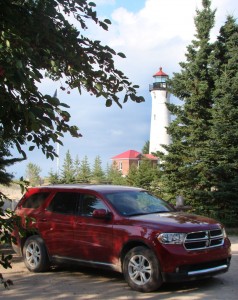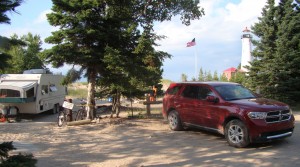In some ways, the Chrysler Group and its Dodge brand and Northern Michigan’s Crisp Point Lighthouse have a lot in common.
That both are with us is one part luck, mixed with a freighter full of determination.
Both have survived – against all odds.
To test Dodge’s new Durango sport utility, we pulled our loaded 2,500-camper on a 980-mile trip, packed with the usual supplies needed for a seven-day stay in the wilds of Michigan’s Upper Peninsula to serve as volunteer keepers at the lonely lighthouse on the coast of Lake Superior. Oh, and four people and a dog were part of the equation, so human and canine comfort were paramount.
This all-wheel-drive Durango proved to be the perfect perch to make the trip. Three rows – all adult comfortable – meant everyone had plenty of space. Easy-flip seats made getting in and out a snap, even for the young adult consigned to the back row. Chrysler’s new corporate 3.6-liter V-6 provided plenty of power to shoulder the heavy load, even if unloaded acceleration seems rather middle-of-the-pack.
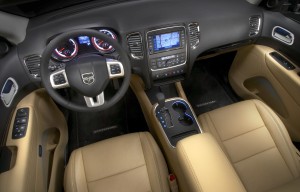
The Durango's interior may not be as beautiful as the designs from some other automakers, but it is certainly well built.
Anyone familiar with the first two generations of Dodge’s popular Durango will hardly recognize gen 3. Stylistically, the Durango gives up its trademark son-of-Ram front end with the pronounced hood and fenders for a sleek and slippery shape. The original and updated gen 2 were massive, old-school body-on-frame trucks that were just slightly smaller than the competition from Ford and General Motors. But the world has changed and Chrysler saw the handwriting on the wall – there wasn’t room for three full-size domestic SUVs and as good as the second generation was, the smaller automaker wasn’t going to be able to compete in that market.
So the new truck starts with bones that were donated by the Mercedes M-Class, a platform that also underpins the new Jeep Grand Cherokee. Essentially, the Durango is the seven-passenger version of the critically acclaimed Jeep.
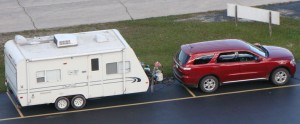
The Durango had little trouble pulling a loaded 2,500-pound camper. That's not surprising since it is rated to tow 6,200 pounds with the standard V-6.
What was an old-school brute is now a relatively svelte unibody crossoverish SUV. Where there was a solid rear axle, the Durango gets a sophisticated independent setup.
Yep, criticism of the Chrysler-Daimler “merger of equals” has been easy for much of the last decade – in fact, many in the auto scribe business have all but made a living doing it – but there’s no denying that Chrysler was finally starting to see some good things out of the partnership.
One of those good things is the new V-6, which it developed with the Daimler’s help. The engine will eventually replace a ridiculous seven different V-6 engines powering vehicles in Chrysler’s fleet. Finally, Chrysler has a modern V-6 engine.
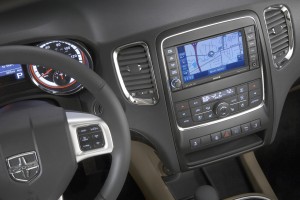
Everything in the Durango's interior works with precision that was missing in many past Dodge vehicles.
Like Chrysler, the 1904 light at Crisp Point, was virtually left for dead. That was until the late 1980s when Don and Nellie Ross stumbled upon the lonely and virtually forgotten sentinel – the most remote mainland light in the entire state – and decided that they would make it their retirement project. Beyond that, it became their enduring legacy.
When it was built, the light was located hundreds of feet from the Lake Superior shore, 14 miles west of the much more famous Whitefish Point Lighthouse. But piers built out into the lake for a lifesaving station and for ships to bring in supplies for the lighthouse keepers changed the way the water replenished sand on the shore in front of the lighthouse.
So by the mid-90s, the water was lapping at the 58-foot beacon’s foundation and a storm had literally ripped off its attached service building. Before long, the tower would be claimed by the sea.
But the Rosses coaxed the county road commission into clearing the old logging road that led to the light and found donors to pay for massive boulders to guard the old lady’s foundation.
Since then, the Crisp Point Lighthouse Historical Society has been able to begin redeveloping the site. It rebuilt the attached service building and then built a replica of the original foghorn building to serve as a visitors’ center. Now a steady stream of volunteer lighthouse keepers take turns camping at the site all summer long.
Click here to learn more about visiting Crisp Point Lighthouse.
There’s a fair amount of work to do, but the reward comes in the evening when the visitors leave and you have miles of deserted Lake Superior beach all to yourself. The unbelievable sunsets and sunrises will take your breath away.
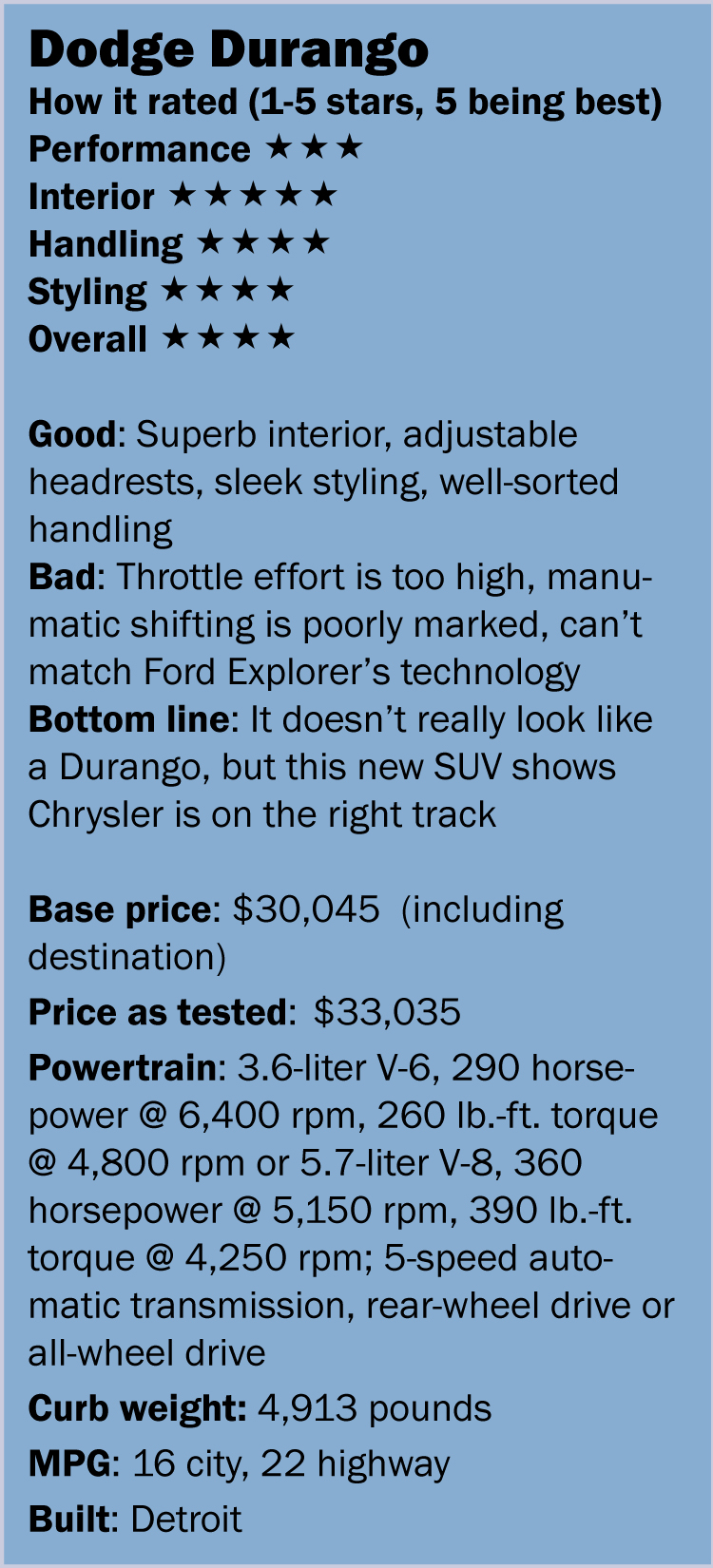 The trip north to visit the light was easy. The Durango barely worked up a sweat pulling the camper and it made quick work of the hills in the northern Lower Peninsula. The last five miles are along a sandy, twisty, one-lane road. The Durango’s all-wheel drive meant we never spun a tire. The truck’s anti-lock brakes actually kicked in a couple of times in steep downhill turns.
The trip north to visit the light was easy. The Durango barely worked up a sweat pulling the camper and it made quick work of the hills in the northern Lower Peninsula. The last five miles are along a sandy, twisty, one-lane road. The Durango’s all-wheel drive meant we never spun a tire. The truck’s anti-lock brakes actually kicked in a couple of times in steep downhill turns.
Like the lighthouse, Chrysler has also had its own savior. Fiat’s CEO Sergio Marchionne stepped in and told the Auburn Hills-based design staff to get to work. Where the automaker had planned some light updates and a few new models, Marchionne knew that the only way for Chrysler to survive would be for it to step up its game across the board. For 2011, the automaker significantly updated almost every vehicle in its lineup.
That game plan is in stark contrast to the way Chrysler’s previous master had run the company. Toward the end of the Daimler rule, Chrysler was ordered to cut costs and it showed. Ancient engines soldiered forward in an era when virtually every other automaker was forging ahead with gas-sipping new designs. Interiors pieces were chintzy. Quality was poor. Suspensions were poorly tuned. And the styling looked as though the automaker had been forced to rush instead of spending the time to sculpt unique, special cars.
So Marchionne’s plan is a complete breath of fresh air and it’s reflected in this new Durango.
The new engine is very good. While fuel mileage could be better, it will likely go up when Chrysler starts installing a new eight-speed automatic transmission, replacing the current five-speed. We saw 12 mpg with the trailer attached for virtually the entire week.
The interior is wonderful. While the Chrysler’s new corporate interior style isn’t quite as glamorous as some other automakers, it all works superbly and there isn’t a rough edge anywhere. Of particular note, Chrysler’s seat engineers designed a system that is class-leading for ease of use. A simple flip of a lever folds the third-row seats. Passengers back there can pull a red strap to easily fold the middle-row. Getting in is just as easy. Flip one lever and the seat folds. Keep holding it and it flips forward. The same lever also adjusts the seatback. Simple.
And the styling is well executed. The look doesn’t seem to have much in common with past Durangos, but there’s no denying that the stylists spent a considerable time working the details. Some recent Chrysler designs – think Chrysler Sebring, Jeep Compass/Patriot, Dodge Avenger, Dodge Nitro – look like they were penned by first-year design students on internships. Not this one.
One oddity is the extremely short front overhang, compared to the rather long rear overhang. It looks like someone grabbed the back end of the model in clay and pulled. Also, the roofline is high, but that contributes to expansive headroom, even for those sitting in the third row.
The Durango’s ride is excellent and it handles well for a sport ute weighing nearly 5,000 pounds. The Durango starts as a rear-driver. Adding all-wheel-drive bumps the price up $2,000 to $2,400, depending on trim level.
While the 3.6 is standard, yes, you can get it with a 360-horsepower 5.7 liter Hemi V-8.
The Durango starts at $30,045, including destination for a RWD model. With the optional inferno red color ($295), AWD and towing package ($695), this one rang the cash register to the tune of $33,035.
So equipped, the Durango can tow 6,200 pounds, so our camper hardly tested it. The Durango’s towing maxes out at 7,400 pounds with a RWD Hemi-equipped model.
Standard features include automatic three-zone climate control, 6-speaker stereo, three-row seating (standard on all trim levels except the Heat performance version) and the most curious feature – a button that automatically lowers the headrests on the third-row seats. Push it with one of the little squirts sitting back there to bop them on the head.
Chrysler isn’t completely out of the woods. As good as it is, the automaker is still way behind on technology. For example, compare the Durango to the new Ford Explorer, with its envelope-pushing MyFordTouch infotainment system, high-tech, fuel-saving engines and industry-first inflatable middle-row seatbelts. On those fronts, Dodge is still behind.
The Ford gets better fuel mileage 20/28 for a front-wheel-drive model, but it tows less – maxing out at 5,000 pounds.
But Dodge – and Chrysler as a whole – should celebrate this new Durango. It’s a remarkably good vehicle, executed in a very short timeframe under severe pressure.
What will Chrysler be able to do with the full backing of a technologically advanced company such as Fiat, one that understands that selling vehicles requires real investment? Only time will tell if this new partnership will be fruitful or just another in a long line of corporate masters that ultimately didn’t know how to manage the smallest of the Detroit Three automakers.

